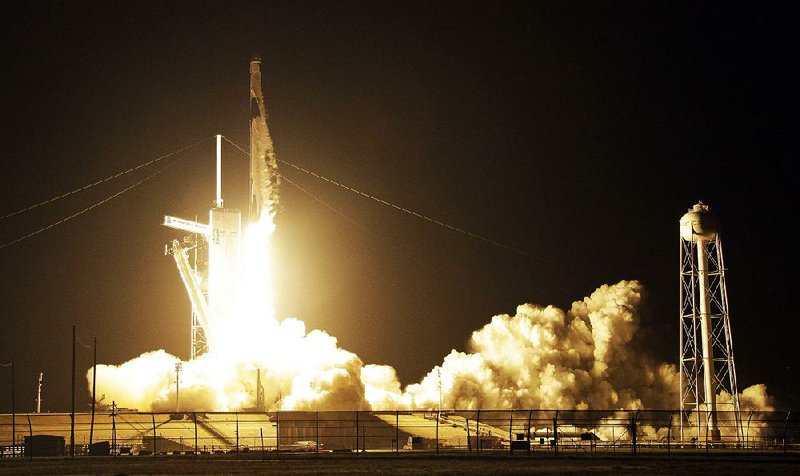The first U.S. spacecraft capable of carrying astronauts since the retirement of the space shuttles launched early Saturday. A successful mission stands to put NASA and the United States on the cusp of a renewed era of human spaceflight.
There were no people on this demonstration flight, a SpaceX vehicle called Crew Dragon. As lightning sparked in distant skies, the spacecraft lifted off at the appointed time, 2:49 a.m., from NASA's Kennedy Space Flight Center in Florida. Within 10 minutes the capsule was in orbit, headed toward a rendezvous this morning with the International Space Station.
"Tonight was a big night for the United States of America, a great night for NASA," Jim Bridenstine, the NASA administrator, said during a news conference after the launch.
The launch was also an important step for the goals of Elon Musk, who founded SpaceX in 2002 and who says the objective of the company is to send people to space and eventually Mars. "It's been 17 years to get to this point," said Musk.
He described himself as emotionally exhausted. "But it worked," Musk said of Crew Dragon. "So far."
To date, the company has sent into space only satellites and cargo (and one Tesla sports car). "We still haven't launched anyone yet, but hopefully, we will later this year," Musk said. "So that would definitely be a culmination of a long dream for a lot of people, me and a lot of people at SpaceX."
For the past eight years, NASA has been paying for rides on Russian spacecraft to get its astronauts to and from the space station. Instead of developing and operating its own replacement for the shuttles, NASA has instead turned to private companies to provide that service. In 2014, the space agency awarded two contracts, to SpaceX and to Boeing.
The mission that launched Saturday, known as Demo-1, is an end-to-end test of the spacecraft from launch to docking at the orbiting outpost to re-entering over the United States and splashing down in the Atlantic Ocean.
The capsule is to arrive at the space station today, about 27 hours after launch. Unlike earlier SpaceX missions that took cargo to the space station, which approached from below and was then grabbed by the station's robotic arm, the Crew Dragon capsule will approach from the front and autonomously dock.
After five days at the station, it is scheduled to leave Friday.
Musk said the most critical portions of the mission are the docking and the re-entry. The Crew Dragon's top half has a more complex shape compared with an earlier version of SpaceX's capsule that carries only cargo. That could cause it to tumble in the atmosphere.
The capsule can seat up to seven astronauts, although the early flights will not be filled to capacity. For this demonstration flight, one of the four seats is occupied with a sort of artificial person -- what NASA calls an ATD or "anthropomorphic test device" -- which is wearing a SpaceX spacesuit. The device includes sensors to measure forces and accelerations that a person would experience on the trip.
The SpaceX engineers named it Ripley, after the heroine in the Alien movies played by Sigourney Weaver. The Ripley dummy was accompanied by a plush globe intended to signal when the capsule had escaped Earth's gravity. Video footage in a tweet by Musk showed the toy lifting from its seat during orbit.
It is also carrying 400 pounds of cargo as well as inserts that simulate the mass of a more completely filled capsule. Engineers on the ground will use information from the flight to understand how the spacecraft responds to being filled.
NASA officials say that they expect that not everything will work perfectly; the purpose of the demonstration flight is to identify potential problems, and fix them, before putting people aboard.
SpaceX has another high-stakes uncrewed test scheduled for June. The same capsule will again launch on top of a Falcon 9 rocket, but the flight will simulate a malfunction in the rocket high in the atmosphere. The escape system is to then propel the capsule to safety.
If that test succeeds, then perhaps as soon as July, two NASA astronauts, Robert Behnken and Douglas Hurley, are to make a demonstration flight to the space station. "Seeing a success like this definitely gives us a lot of confidence in the future," Behnken said at the news conference.
Operational missions carrying four astronauts would then follow.
The first crewless test flight of Boeing's capsule, Starliner, could occur as soon as next month and a first crewed flight also could take off this year.
However, after years of delays, the schedules for Boeing and SpaceX could still slip further if additional technical issues arise. NASA is considering buying more Russian Soyuz seats should crewed flights not occur this year.
A Section on 03/03/2019

